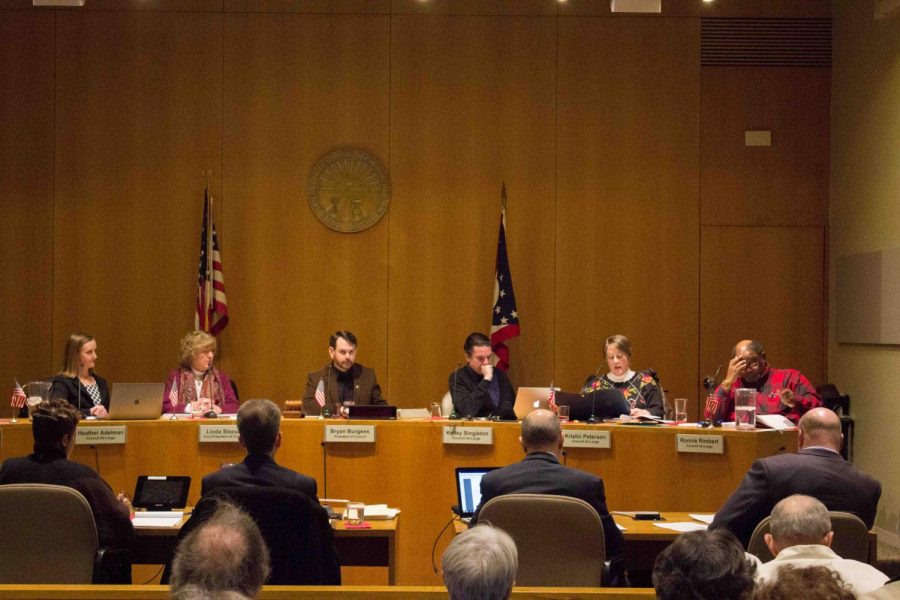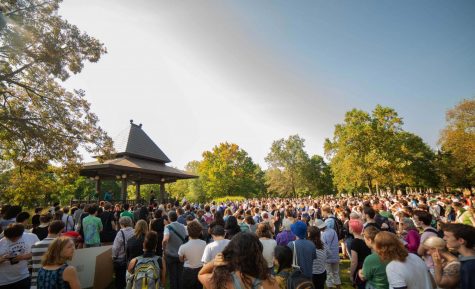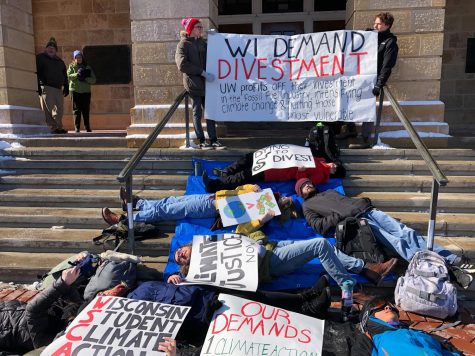City Council Continues Environmental Emphasis
City Council members deliberate at a February 2018 meeting.
Following months of debate, Oberlin residents voted in 2017 to allocate $2.8 million to realize the goals outlined in the third iteration of the Oberlin Climate Action Plan, originally envisioned in 2011. Broadly, the plan’s current focus is to work toward carbon neutrality and to assist Oberlin residents who are interested in sustainable space heating and transportation opportunities. Efforts toward achieving these goals are currently underway.
The most recent plan reaffirms the goal of the 2011 CAP to eliminate the use of fossil fuels in electricity generation by 2050. According to Sustainability Coordinator Linda Arbogast, 85 percent of the City’s power portfolio currently consists of renewable energy sources. Additionally, the 2019 update focuses heavily on the City’s aim to “transition from fossil fuels to carbon-neutral alternatives in energy sectors for space heating and transportation.”
The goals set in the 2019 CAP will be funded in part by the Sustainable Reserve Fund. This fund is sourced by the sale of Renewable Energy Credits, certificates proving that one megawatt-hour of electricity was produced from a renewable energy source. Green energy providers can receive RECs from a variety of certifying agencies. The REC system was created so that states could track their progress and compliance with their renewable portfolio standards. The City of Oberlin made $2.8 million by selling their RECs on the open market between 2014 and 2018.
The REC revenue initially went into an Oberlin Municipal Light and Power System fund called the Sustainable Reserve Program, which can only be spent on electricity expenses. To avoid these restrictions, the City established a new fund — the SRF. According to Bryan Burgess, who has sat on City Council for the past decade and served as its president for the last two before reaching his term limit, Oberlin is the first city to engage in this kind of process to create a new fund.
However, the City of Oberlin only decided to dedicate these funds to the CAP’s sustainability efforts after months of tense debate and disagreement. City Council was split between dedicating the REC sales to the Sustainable Reserve Program or returning the money to ratepayers by applying discounts to their monthly electricity bills.
“The [Council] election of 2015 was basically around that whole question of what to do with the Sustainable Reserve Funds,” City Council President Linda Slocum said.
In 2016, City Council — with two newly elected members — voted to give 85 percent of the REC revenue to ratepayers and allocate the remaining 15 percent to the Sustainable Reserve Program.
John Elder, OC ’53, and a resident of Kendal at Oberlin, is the founder of Communities for Safe and Sustainable Energy, a group that advocated for the REC money to be dedicated to the SRF. In response to City Council’s decision, Elder; current Councilmember Elizabeth Meadows; Jessa Klotz New, OC ’01; Associate Professor of Africana Studies Charles Peterson, and current City Council Vice President Heather Adelman organized to put the issue up for a vote.
In November 2017, Oberlin residents passed an amendment to Ordinance 07-39 to allocate all of the REC revenue to the Sustainable Reserve Program, before the SRF was established in the summer of 2018. Elder explained his perspective on the debates that circulated at the time.
“One false argument was that Oberlin’s electric rates were high, whereas as a matter of fact, they are as low as — if not lower than — most comparable communities,” Elder said. “The second false argument was that giving a rebate would help people’s finances. What was obscured was the fact that if you give it prorated on the basis of the electrical usage, the bulk of the money goes to the big ratepayers — which would be the [Federal Aviation Administration], Oberlin College, Walmart. The less electricity you use, the smaller amount you would get. So there was no rebalancing of the economics.”
Under the rebate proposal, households would receive an average of $89 per year for three to five years, reducing resident’s electricity bills by about $7–$8 a month.
SRF proponents argued that the money could be better used to weatherize residences and make them more energy efficient, improvements that had the potential to save small ratepayers more money in the long term.
“It was such a divisive issue,” Slocum said. “Council was split 4–3. It was a very difficult time, but we made it through. And I’m pleased to say, I think we’ve come out a better council and a better city government for it.”
Burgess explained that the SRF enabled the city to set more deliberate goals than they had been able to envision in their previous plan, published in 2013.
“Even more ambitious targets were set, more specifically with the creation of the Sustainable Reserve Fund,” he said. “The first two Climate Action Plans didn’t provide funding mechanisms. [They] also didn’t provide many implementation mechanisms. With the adoption of the third Climate Action Plan most recently, not only did we establish the Sustainable Reserve Fund to help finance them, but we established the Office of Sustainability in City Hall in order to oversee and implement the policies.”
Arbogast works full-time to oversee the CAP’s implementation, which includes managing the SRF. Arbogast reviews proposals for SRF funding from organizations who are interested in collaborating with the City of Oberlin on sustainability efforts. The guidelines for SRF proposals specify that the proposal must directly address the goals of the CAP.
“The proposals can come from anyone — it doesn’t have to be a large established organization,” Arbogast explained. “I am really looking to make sure that as we look at all these proposals, that it is fair that people of all incomes get supported by this funding.”
In their most recent CAP, the city further elaborated on its goals to promote social equity.
“Social equity played a huge component in the third iteration of the Climate Action Plan — recognizing that if we wanted to accomplish these goals of carbon reductions in our community, we had to find ways that we could make that affordable for everyone in the community,” Burgess explained.
While the plan reiterates the goal that the City of Oberlin set in previous iterations — to eliminate fossil fuels — it further highlights the challenges that space heating and transportation present, and emphasizes the need to assist residents who are interested in shifting to carbon-neutral alternatives.
“Gas for heating and for transportation are the largest sort of buckets of emissions that we feel like we can target at this point,” Arbogast said. “I’ve been working with [Efficiency Smart] to think harder about heating, and we are trying to gear up heat pumps. We’re going to be offering greater rebates for people who will electrify the heating of their homes through switching over from gas to using all electric. It’s a tough sell right now because [of] the fracking [in] Ohio. Locally, gas is cheap. We have to offer incentives to people to be able to consider that as an option.”
The City also has an ongoing annual contract with Providing Oberlin With Efficiency Responsibly, funded by the SRF. POWER is a nonprofit organization that works to help lower-income residents weatherize and repair their houses. Alongside these energy efficiency initiatives, Arbogast is also exploring different opportunities to make sustainable transportation more accessible in Oberlin.
“We’re going to look at increasing our electric [car] infrastructure,” she said. “We’re going to look at offering incentives, but we’re also going to have an electric car rideshare so that anyone can utilize an electric car and start to become familiar with the technology.”
While Arbogast oversees smaller proposals, any project that amounts to funding of $50,000 or more gets approved by City Council. Arbogast plans to bring City Council a proposal from the Cleveland start-up Sway Mobility, which hopes to bring two electric cars to Oberlin that residents could rent by the hour.
In addition to homeowners, Arbogast collaborates with large entities in Oberlin, including the College.
“The College has its own climate action plan that is more ambitious than the community one,” Arbogast said. “I work with a lot of College faculty, students, [and] administrators, because our plan is comprehensive, so it obviously includes the College. We want the College’s plan to succeed because it supports our effort to succeed.”
The SRF has also been utilized recently to respond to the COVID-19 crisis. After the pandemic prompted Oberlin City Schools to transition to remote learning, the City committed to withdrawing up to $26,000 from the SRF to fund a program that provides students with internet access in collaboration with the Oberlin Cable Co-op and Oberlin City Schools.
“Based on promoting resiliency and education and awareness, we provided some funds to the Cable Co-op specifically to assist families,” City Manager Rob Hillard said. “We believe this is consistent with the plan itself.”
The CAP set goals to increase community “education and outreach” and “resilience,” two issues Hillard believes this initiative addresses during a time of increased need. Hillard stated that he did not believe this use of the fund would impact the City’s goals to eliminate fossil fuels from the power portfolio by 2050.
Although the establishment of the SRF was initially disputed, today councilmembers are largely supportive of the developments that have been made and look forward to exploring opportunities for increasing sustainability in the future.
“It isn’t easy being first,” Burgess said. “If we could point to another city that had done this and followed their example, we probably could have done this faster and better. But it’s interesting now seeing how other cities [in Ohio] have emulated what we’ve done … [like] Athens and Cincinnati. And actually, those two cities have instituted some programs that I think would be fantastic to do here in Oberlin.”







